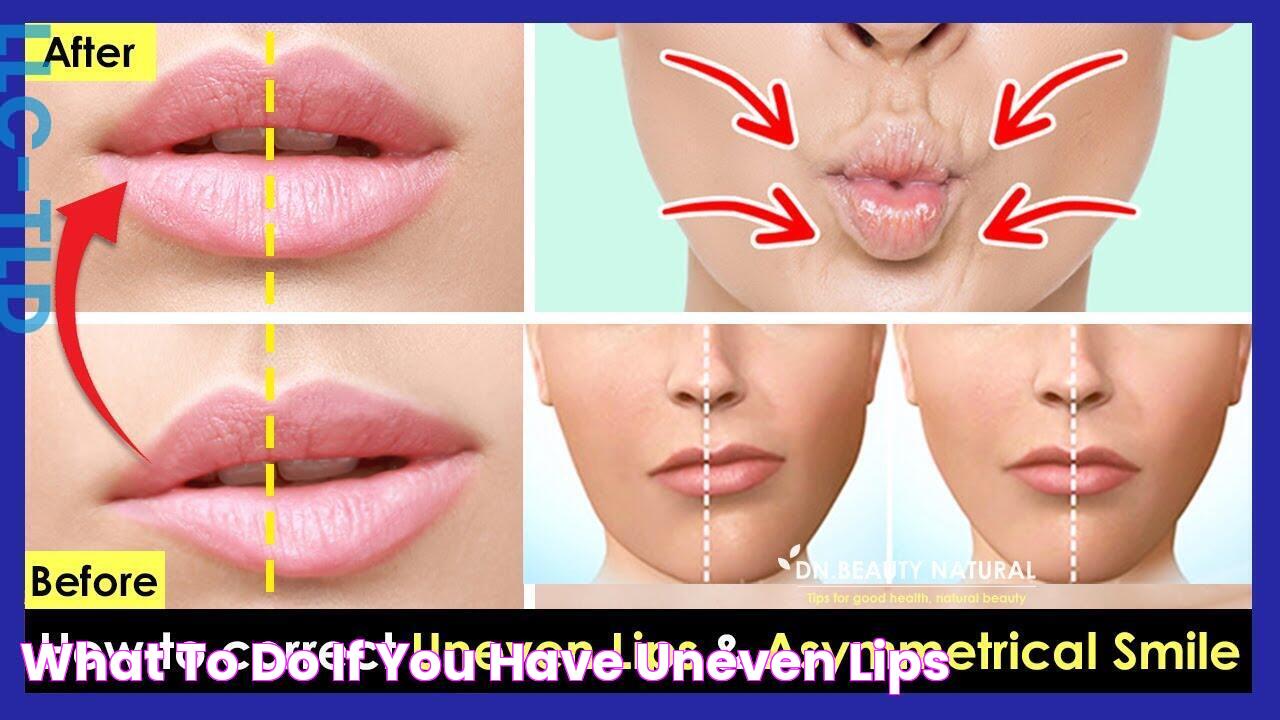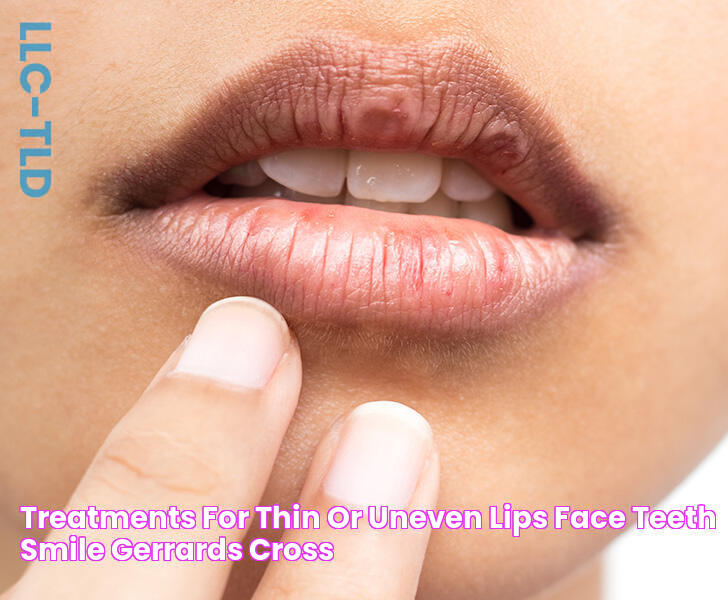Why Your Lips Are Uneven: Causes, Treatments, And More
Uneven lips, also known as lip asymmetry, refer to a noticeable difference in the size, shape, or fullness of the upper and lower lips. This variation can be a natural characteristic or result from underlying factors.
Uneven lips can have various causes, including genetics, trauma, and medical conditions. In some cases, it may be a symptom of an underlying neurological disorder or a side effect of certain medications. Additionally, lifestyle factors such as sun exposure, smoking, and dehydration can contribute to lip asymmetry over time.
Understanding the causes of uneven lips is essential for proper diagnosis and treatment. In some cases, medical intervention may be necessary to address underlying health conditions or improve lip symmetry. However, for many individuals, uneven lips are simply a natural variation that does not require medical attention.
Read also:Unbelievable Discover The Riches Of Ed Kelce Net Worth Unveiled
Uneven Lips Causes
Uneven lips, also known as lip asymmetry, refer to a noticeable difference in the size, shape, or fullness of the upper and lower lips. This variation can be a natural characteristic or result from underlying factors.
- Genetics
- Trauma
- Medical conditions
- Medications
- Sun exposure
- Smoking
- Dehydration
- Neurological disorders
Understanding the causes of uneven lips is essential for proper diagnosis and treatment. In some cases, medical intervention may be necessary to address underlying health conditions or improve lip symmetry. However, for many individuals, uneven lips are simply a natural variation that does not require medical attention.
1. Genetics
Genetics play a significant role in determining the size, shape, and fullness of lips. Individuals inherit genes from both parents that influence the development of facial features, including the lips.
- Gene Expression
Genes provide instructions for the production of proteins that are responsible for various bodily functions and characteristics. In the case of lips, specific genes regulate the production of proteins involved in lip development and growth.
- Variations in Gene Sequences
Variations or mutations in gene sequences can lead to changes in the structure or function of the proteins they encode. These variations can affect lip development, resulting in uneven lips.
- Inheritance Patterns
Uneven lips can be inherited in different patterns, including dominant, recessive, or polygenic inheritance. The inheritance pattern determines the likelihood of a child inheriting the trait from their parents.
Read also:
- The Life And Legacy Of Harold Ramis A Cinematic Genius
- Syndromic Associations
In some cases, uneven lips may be associated with genetic syndromes or disorders that affect multiple body systems. These syndromes can include underlying medical conditions that contribute to lip asymmetry.
Understanding the genetic basis of uneven lips is crucial for proper diagnosis and genetic counseling. By identifying the specific genes or genetic variations involved, healthcare professionals can provide accurate information about inheritance patterns and potential health implications.
2. Trauma
Trauma, whether physical or emotional, can contribute to uneven lips. Physical trauma, such as a lip injury or surgery, can directly affect the shape and structure of the lips, leading to asymmetry. Emotional trauma, on the other hand, can indirectly impact lip appearance through stress-related behaviors like lip biting or picking.
Physical Trauma
Direct trauma to the lips, such as a cut, burn, or impact, can cause scarring or tissue damage. This damage can affect the elasticity and shape of the lips, resulting in unevenness. Surgical procedures, like lip augmentation or reduction, can also lead to lip asymmetry if not performed carefully.
Emotional Trauma
Emotional trauma can manifest in various physical symptoms, including lip-related behaviors. Stress-induced lip biting or picking can damage the delicate lip tissue, causing inflammation, scarring, and unevenness. Additionally, emotional trauma can lead to dehydration, which can worsen lip asymmetry by reducing lip fullness.
Understanding the connection between trauma and uneven lips is crucial for proper diagnosis and treatment. If trauma is suspected as a contributing factor, addressing the underlying emotional or physical issues can be essential for improving lip symmetry and overall well-being.
3. Medical conditions
Various medical conditions can contribute to uneven lips, ranging from neurological disorders to systemic diseases. Understanding the underlying medical cause is crucial for proper diagnosis and treatment.
- Neurological Disorders:
Conditions that affect the nervous system, such as Bell's palsy or stroke, can cause facial muscle weakness or paralysis, leading to uneven lips. These disorders disrupt nerve signals that control lip movement and shape.
- Cleft Lip and Palate:
A birth defect that occurs when the lip or palate does not fully form during pregnancy, resulting in a gap or opening. This condition can cause significant lip asymmetry and may require surgical intervention to correct.
- Inflammatory Conditions:
Chronic inflammation, such as that caused by autoimmune diseases like lupus or Crohn's disease, can affect the lips, leading to swelling, tissue damage, and unevenness.
- Cancer and Other Tumors:
Tumors or growths in or around the lips can cause asymmetry by displacing or compressing surrounding tissues. These may be benign (non-cancerous) or malignant (cancerous) and require medical attention.
These medical conditions underscore the complex relationship between overall health and lip appearance. By identifying and addressing the underlying medical cause, healthcare professionals can effectively manage uneven lips and improve overall patient outcomes.
4. Medications
Medications can contribute to uneven lips as a side effect. Certain drugs, such as isotretinoin (Accutane), which is used to treat severe acne, can cause dryness and inflammation of the lips, leading to unevenness. Other medications, such as corticosteroids, can also cause lip changes, including thinning and flattening, which can contribute to asymmetry.
Understanding the potential side effects of medications is crucial for healthcare professionals and patients alike. By being aware of the possible impact on lip appearance, appropriate measures can be taken to prevent or manage uneven lips caused by medications.
In some cases, alternative medications or dosage adjustments may be necessary to minimize the risk of lip asymmetry. Additionally, regular monitoring of lip health and the use of lip care products can help mitigate the effects of medications on the lips.
5. Sun exposure
Sun exposure is a significant environmental factor that can contribute to uneven lips. Prolonged and unprotected exposure to ultraviolet (UV) rays from the sun can damage the delicate lip tissue, leading to a range of changes that can result in lip asymmetry.
- Photoaging
UV radiation breaks down collagen and elastin, the proteins responsible for skin elasticity and firmness. Over time, this can lead to thinning and wrinkling of the lips, making them more prone to unevenness and asymmetry.
- Hyperpigmentation
Sun exposure can stimulate the production of melanin, the pigment that gives skin its color. Uneven sun exposure can lead to hyperpigmentation, resulting in darker patches or spots on the lips, contributing to lip asymmetry.
- Lip Dehydration
UV rays can dehydrate the lips, drawing moisture away from the delicate skin. Dehydrated lips are more susceptible to cracking, peeling, and uneven texture, further contributing to asymmetry.
- Lip Cancer
Excessive sun exposure is a major risk factor for lip cancer. UV radiation can damage the DNA in lip cells, potentially leading to the development of cancerous growths. Lip cancer can cause significant lip asymmetry and requires prompt medical attention.
Understanding the impact of sun exposure on the lips is crucial for preventing and managing uneven lips. Protective measures, such as wearing lip balm with SPF, seeking shade, and limiting sun exposure during peak hours, are essential for maintaining healthy, even lips.
6. Smoking
Smoking, the act of inhaling and exhaling the smoke produced by burning tobacco, has a detrimental impact on overall health, including the appearance of the lips. The chemicals present in tobacco smoke damage the delicate lip tissue, leading to a range of changes that can contribute to uneven lips.
- Lip Dehydration
Tobacco smoke contains numerous chemicals that can dehydrate the lips, stripping them of their natural moisture. Dehydrated lips become dry, cracked, and more susceptible to environmental damage, resulting in uneven texture and appearance.
- Premature Aging
Smoking accelerates the aging process of the skin, including the lips. The chemicals in tobacco smoke damage collagen and elastin, proteins responsible for skin elasticity and firmness. As a result, smokers' lips may develop wrinkles, fine lines, and a loss of volume, contributing to unevenness.
- Lip Discoloration
Tobacco smoke contains tar and other particles that can stain the lips, leading to discoloration and uneven pigmentation. This can result in darker patches or spots on the lips, further contributing to lip asymmetry.
- Delayed Wound Healing
Smoking impairs the body's natural wound healing processes. This can affect the healing of any injuries or wounds on the lips, potentially leading to scarring and unevenness. Additionally, smoking can increase the risk of developing lip cancer, a serious condition that can cause significant lip damage and asymmetry.
Given the significant impact of smoking on lip health, cessation is crucial for preventing and managing uneven lips. Seeking professional help, utilizing nicotine replacement therapies, and gradually reducing tobacco consumption can aid in quitting smoking and improving overall lip appearance.
7. Dehydration
Dehydration, an insufficient intake of fluids, can significantly contribute to uneven lips. When the body lacks adequate hydration, the delicate skin of the lips becomes dry and susceptible to damage, leading to a range of issues that can result in lip asymmetry.
The outermost layer of the lips consists of a thin, protective barrier that relies on hydration to maintain its integrity. Dehydration disrupts this barrier, allowing moisture to escape and environmental irritants to penetrate. This can lead to dryness, cracking, peeling, and inflammation, all of which can contribute to uneven lip texture and appearance.
In addition, dehydration can affect the overall volume of the lips. Plump, hydrated lips are typically more symmetrical, while dehydrated lips may appear thinner and uneven due to a loss of fullness. This can be particularly noticeable in individuals with naturally thin lips or those who have experienced significant fluid loss.
Understanding the link between dehydration and uneven lips is crucial for maintaining healthy, symmetrical lips. Adequate fluid intake, especially water, is essential for overall hydration and lip health. Avoiding excessive caffeine and alcohol consumption, as these substances can further dehydrate the body, is also important.
By prioritizing hydration and incorporating lip care products that support moisture retention, individuals can effectively prevent and manage uneven lips caused by dehydration.
8. Neurological disorders
Neurological disorders are a group of conditions that affect the nervous system, which includes the brain, spinal cord, and nerves. These disorders can range from common conditions like migraines to serious conditions like stroke and Parkinson's disease.
One of the lesser-known symptoms of neurological disorders is uneven lips. This can be caused by a variety of factors, including:
- Muscle weakness or paralysis: Neurological disorders can cause weakness or paralysis of the muscles in the face, including the lips. This can lead to uneven lips, as one side of the mouth may droop or be unable to move as well as the other side.
- Sensory loss: Neurological disorders can also cause loss of sensation in the face, including the lips. This can make it difficult to control the movement of the lips, which can lead to unevenness.
- Involuntary muscle movements: Some neurological disorders, such as Parkinson's disease, can cause involuntary muscle movements. These movements can affect the lips, causing them to tremble or move uncontrollably. This can also lead to uneven lips.
Uneven lips can be a sign of a neurological disorder, especially if they are accompanied by other symptoms such as weakness, numbness, or difficulty speaking. If you are experiencing uneven lips, it is important to see a doctor to rule out any underlying neurological conditions.
Treatment for uneven lips caused by a neurological disorder will depend on the underlying cause. In some cases, treatment may involve physical therapy to strengthen the muscles in the face or medication to control involuntary muscle movements. In other cases, surgery may be necessary to correct the unevenness of the lips.
Frequently Asked Questions about Uneven Lips Causes
This section addresses common concerns and misconceptions regarding the causes of uneven lips, providing concise answers based on medical knowledge.
Question 1: Can uneven lips be a sign of a serious underlying condition?
Answer: While uneven lips are often a result of natural variations or lifestyle factors, they can sometimes indicate an underlying medical condition, particularly if accompanied by other symptoms. Neurological disorders, such as Bell's palsy or stroke, can cause facial muscle weakness or paralysis, leading to uneven lips. Additionally, certain genetic syndromes or developmental disorders may also manifest with lip asymmetry.
Question 2: What are the most common causes of uneven lips?
Answer: The most prevalent causes of uneven lips include genetics, trauma, and lifestyle factors such as sun exposure and dehydration. Inherited genetic traits determine lip shape and size, while physical injuries or surgical procedures can directly affect lip structure. Sun damage and dehydration can cause unevenness by altering lip texture and volume.
Question 3: Can medications contribute to uneven lips?
Answer: Yes, certain medications, such as isotretinoin and corticosteroids, can have side effects that affect lip appearance. Isotretinoin, used for severe acne, can cause lip dryness and inflammation, while corticosteroids may lead to lip thinning and flattening. It is important to be aware of potential medication side effects and consult a healthcare professional if lip changes occur.
Question 4: How does smoking affect lip symmetry?
Answer: Smoking has detrimental effects on lip health, including increased risk of uneven lips. The chemicals in tobacco smoke dehydrate and damage lip tissue, leading to premature aging, discoloration, and delayed wound healing. These factors contribute to lip asymmetry and compromise overall lip appearance.
Question 5: Can uneven lips be prevented?
Answer: While natural variations in lip symmetry are common, certain lifestyle modifications can help prevent unevenness caused by external factors. Protecting lips from sun damage by using sunscreen, avoiding smoking, and maintaining adequate hydration are crucial for preserving lip health and symmetry.
Question 6: When is it necessary to seek professional advice for uneven lips?
Answer: If uneven lips are accompanied by other symptoms, such as facial weakness, numbness, or difficulty speaking, it is advisable to seek professional medical advice. These symptoms may indicate an underlying neurological disorder or other medical condition that requires proper diagnosis and treatment. Consulting a healthcare professional can help determine the cause of uneven lips and ensure appropriate care.
Understanding the causes of uneven lips is essential for maintaining lip health and addressing any underlying medical concerns. By adopting healthy lifestyle habits, being aware of potential risk factors, and seeking professional advice when necessary, individuals can effectively manage lip symmetry and overall well-being.
Tips for Managing Uneven Lips
Understanding the causes of uneven lips is the first step towards managing and improving their appearance. Here are some tips to help you achieve more symmetrical, healthy lips:
Tip 1: Protect from Sun DamageExcessive sun exposure can contribute to uneven lips due to dehydration and premature aging. Apply a lip balm with SPF regularly to protect your lips from the sun's harmful UV rays.
Tip 2: Quit SmokingSmoking damages the delicate skin of the lips, leading to dryness, wrinkles, and discoloration. Quitting smoking can significantly improve lip health and reduce the risk of unevenness.
Tip 3: Stay HydratedDehydration can cause lips to become dry and cracked, contributing to uneven texture. Drink plenty of fluids, especially water, throughout the day to keep your lips hydrated and healthy.
Tip 4: Use Lip Care ProductsLip balms and treatments specifically designed for uneven lips can help improve their appearance. Look for products that contain moisturizing and nourishing ingredients to hydrate and protect your lips.
Tip 5: Consider Cosmetic ProceduresFor more pronounced unevenness, cosmetic procedures such as lip fillers or surgery may be an option. These procedures can help to restore symmetry and enhance lip shape, but it is important to consult with a qualified healthcare professional to determine the best course of action.
By following these tips, you can effectively manage uneven lips and improve their overall health and appearance. Remember to prioritize sun protection, avoid smoking, stay hydrated, use appropriate lip care products, and consult a healthcare professional for personalized advice or cosmetic interventions.
Uneven Lips Causes
Understanding the causes of uneven lips is crucial for maintaining lip health and addressing underlying medical concerns. Genetics, trauma, lifestyle factors, medications, and neurological disorders can all contribute to lip asymmetry.
Prevention and management of uneven lips involve adopting healthy habits, such as sun protection, avoiding smoking, staying hydrated, and using appropriate lip care products. In some cases, cosmetic procedures may be considered to enhance lip symmetry and shape. Consulting a healthcare professional is essential for personalized advice and to rule out any underlying medical conditions.
By prioritizing lip health and addressing the causes of uneven lips, individuals can achieve more symmetrical, healthy, and aesthetically pleasing lips.
The Ultimate Guide To Virtual DJ For Beginners
Meet The Daughter Of Country Music Legend Dolly Parton!
The Ultimate Guide To Angular Face Hairstyles: Flattering Styles For Your Face Shape


